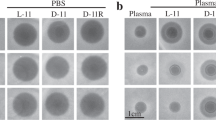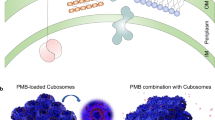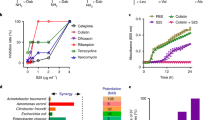Abstract
With the recent emergence of reports on resistant Gram-negative ‘superbugs’, infections caused by multidrug-resistant (MDR) Gram-negative bacteria have been named as one of the most urgent global health threats due to the lack of effective and biocompatible drugs. Here, we show that a class of antimicrobial agents, termed ‘structurally nanoengineered antimicrobial peptide polymers’ (SNAPPs) exhibit sub-μM activity against all Gram-negative bacteria tested, including ESKAPE and colistin-resistant and MDR (CMDR) pathogens, while demonstrating low toxicity. SNAPPs are highly effective in combating CMDR Acinetobacter baumannii infections in vivo, the first example of a synthetic antimicrobial polymer with CMDR Gram-negative pathogen efficacy. Furthermore, we did not observe any resistance acquisition by A. baumannii (including the CMDR strain) to SNAPPs. Comprehensive analyses using a range of microscopy and (bio)assay techniques revealed that the antimicrobial activity of SNAPPs proceeds via a multimodal mechanism of bacterial cell death by outer membrane destabilization, unregulated ion movement across the cytoplasmic membrane and induction of the apoptotic-like death pathway, possibly accounting for why we did not observe resistance to SNAPPs in CMDR bacteria. Overall, SNAPPs show great promise as low-cost and effective antimicrobial agents and may represent a weapon in combating the growing threat of MDR Gram-negative bacteria.
This is a preview of subscription content, access via your institution
Access options
Subscribe to this journal
Receive 12 digital issues and online access to articles
$119.00 per year
only $9.92 per issue
Buy this article
- Purchase on Springer Link
- Instant access to full article PDF
Prices may be subject to local taxes which are calculated during checkout





Similar content being viewed by others
References
World Health Organization. Antimicrobial Resistance: Global Report on Surveillance 2014 (WHO, 2014).
Rice, L. B. Federal funding for the study of antimicrobial resistance in nosocomial pathogens: no ESKAPE. J. Infect. Dis. 197, 1079–1081 (2008).
Rice, L. B. Progress and challenges in implementing the research on ESKAPE pathogens. Infect. Control Hosp. Epidemiol. 31, S7–S10 (2010).
Taubes, G. The bacteria fight back. Science 321, 356–361 (2008).
Xu, Z., Flavin, M. T. & Flavin, J. Combating multidrug-resistant Gram-negative bacterial infections. Exp. Opin. Invest. Drugs 23, 163–182 (2014).
Lee, J. H., Jeong, S. H., Cha, S. & Lee, S. H. A lack of drugs for antibiotic-resistant Gram-negative bacteria. Nat. Rev. Drug Discov. 6, 29–40 (2007). doi:10.1038/nrd2201-c1.
Le Moual, H. & Gruenheid, S. Resistance to antimicrobial peptides in Gram-negative bacteria. FEMS Microbiol. Lett. 330, 81–89 (2012).
Brogden, K. A. Antimicrobial peptides: pore formers or metabolic inhibitors in bacteria? Nat. Rev. Microbiol. 3, 238–250 (2005).
Kohanski, M. A., Dwyer, D. J. & Collins, J. J. How antibiotics kill bacteria: from targets to networks. Nat. Rev. Microbiol. 8, 423–435 (2010).
Zasloff, M. Antimicrobial peptides of multicellular organisms. Nature 415, 389–395 (2002).
Melo, M. N., Dugourd, D. & Castanho, M. A. Omiganan pentahydrochloride in the front line of clinical applications of antimicrobial peptides. Recent Pat. Antiinfect. Drug Discov. 1, 201–207 (2006).
Hancock, R. E. W. & Sahl, H. Antimicrobial and host-defense peptides as new anti-infective therapeutic strategies. Nat. Biotechnol. 24, 1551–1557 (2006).
Zhou, C. et al. High potency and broad-spectrum antimicrobial peptides synthesized via ring-opening polymerization of α-amino acid-N-carboxyanhydrides. Biomacromolecules 11, 60–67 (2010).
Engler, A. C. et al. Effects of side group functionality and molecular weight on the activity of synthetic antimicrobial polypeptides. Biomacromolecules 12, 1666–1674 (2011).
Sulistio, A., Blencowe, A., Widjaya, A., Zhang, X. & Qiao, G. G. Development of functional amino acid-based star polymers. Polym. Chem. 3, 224–234 (2012).
Sulistio, A., Widjaya, A., Blencowe, A., Zhang, X. & Qiao, G. G. Star polymers composed entirely of amino acid building blocks: a route towards stereospecific, biodegradable and hierarchically functionalized stars. Chem. Commun. 47, 1151–1153 (2011).
Wu, W., Wang, W. & Li, J. Star polymers: advances in biomedical applications. Prog. Polym. Sci. 46, 55–85 (2015).
Lam, S. J. et al. Peptide-based star polymers as potential siRNA carriers. Aust. J. Chem. 67, 592–597 (2014).
Byrne, M. et al. Molecular weight and architectural dependence of well-defined star-shaped poly(lysine) as a gene delivery vector. Biomater. Sci. 1, 1223–1234 (2013).
Sulistio, A. et al. Folic acid conjugated amino acid-based star polymers for active targeting of cancer cells. Biomacromolecules 12, 3469–3477 (2011).
Nederberg, F. et al. Biodegradable nanostructures with selective lysis of microbial membranes. Nat. Chem. 3, 409–414 (2011).
Liu, L. et al. Self-assembled cationic peptide nanoparticles as an efficient antimicrobial agent. Nat. Nanotech. 4, 457–463 (2009).
Ng, V. W. L., Ke, X., Lee, A. L. Z., Hedrick, J. L. & Yang, Y.-Y. Synergistic co-delivery of membrane-disrupting polymers with commercial antibiotics against highly opportunistic bacteria. Adv. Mater. 25, 6730–6736 (2013).
Campos, M. A. et al. Capsule polysaccharide mediates bacterial resistance to antimicrobial peptides. Infect. Immun. 72, 7107–7114 (2004).
Llobet, E., Tomas, J. M. & Bengoechea, J. A. Capsule polysaccharide is a bacterial decoy for antimicrobial peptides. Microbiology 154, 3877–3886 (2008).
Melo, M. N., Ferre, R. & Castanho, M. A. R. B. Antimicrobial peptides: linking partition, activity and high membrane-bound concentrations. Nat. Rev. Microbiol. 7, 245–250 (2009).
Choi, H., Chakraborty, S., Liu, R., Gellman, S. H. & Weisshaar, J. C. Medium effects on minimum inhibitory concentrations of nylon-3 polymers against E. coli. PLoS ONE 9, e104500 (2014).
Davis, S. D. Activity of gentamicin, tobramycin, polymyxin B, and colistimethate in mouse protection tests with Pseudomonas aeruginosa. Antimicrob. Agents Chemother. 8, 50–53 (1975).
Velkov, T. et al. Teaching ‘old’ polymyxins new tricks: new-generation lipopeptides targeting Gram-negative ‘superbugs’. ACS Chem. Biol. 9, 1172–1177 (2014).
Li, W. et al. Proline-rich antimicrobial peptides: potential therapeutics against antibiotic-resistant bacteria. Amino Acids 46, 2287–2294 (2014).
Hilchie, A. L., Wuerth, K. & Hancock, R. E. W. Immune modulation by multifaceted cationic host defense (antimicrobial) peptides. Nat. Chem. Biol. 9, 761–768 (2013).
Lee, H. J. et al. Synergistic activity of colistin and rifampin combination against multidrug-resistant Acinetobacter baumannii in an in vitro pharmacokinetic/pharmacodynamic model. Antimicrob. Agents Chemother. 57, 3738–3745 (2013).
Benincasa, M., Pacor, S., Gennaro, R. & Scocchi, M. Rapid and reliable detection of antimicrobial peptide penetration into Gram-negative bacteria based on fluorescence quenching. Antimicrob. Agents Chemother. 53, 3501–3504 (2009).
Alves, C. S. et al. Escherichia coli cell surface perturbation and disruption induced by antimicrobial peptides BP100 and pepR. J. Biol. Chem. 285, 27536–27544 (2010).
Li, W. et al. Multimerization of a proline-rich antimicrobial peptide, Chex-Arg20, alters its mechanism of interaction with the Escherichia coli membrane. Chem. Biol. 22, 1250–1258 (2015).
Fjell, C. D., Hiss, J. A., Hancock, R. E. W. & Schneider, G. Designing antimicrobial peptides: form follows function. Nat. Rev. Drug Discov. 11, 37–51 (2012).
Freire, J. M. et al. Monitoring antibacterial permeabilization in real time using time-resolved flow cytometry. Biochim. Biophys. Acta. 1848, 554–560 (2015).
Morein, S., Andersson, A., Rilfors, L. & Lindblom, G. Wild-type Escherichia coli cell regulate the membrane lipid composition in a ‘window’ between gel and non-lamellar structures. J. Biol. Chem. 271, 6801–6809 (1996).
Elie, C. R., Hebert, A., Charbonneau, M., Haiun, A. & Schmitzer, A. R. Benzimidazolium-based synthetic chloride and calcium transporters in bacterial membranes. Org. Biomol. Chem. 11, 923–928 (2013).
Erental, A., Sharon, I. & Engelberg-Kulka, H. Two programmed cell death systems in Escherichia coli: apoptotic-like death is inhibited by the mazEF-mediated death pathway. PLoS Biol. 10, e1001281 (2012).
Bayles, K. W. Bacterial programmed cell death: making sense of a paradox. Nat. Rev. Microbiol. 12, 63–69 (2014).
Erental, A., Kalderon, Z., Saada, A., Smith, Y. & Engelberg-Kulka, H. Apoptosis-like death, an extreme SOS response in Escherichia coli. mBio 5, e01426–14 (2014).
Henriques, S. T., Melo, M. N. & Castanho, M. A. R. B. Cell-penetrating peptides and antimicrobial peptides: how different are they? Biochem. J. 399, 1–7 (2006).
Henriques, S. T., Melo, M. N. & Castanho, M. A. R. B. How to address CPP and AMP translocation? Methods to detect and quantify peptide internalization in vitro and in vivo. Mol. Membr. Biol. 24, 173–184 (2007).
Hancock, R. E. W. & Chapple, D. S. Peptide antibiotics. Antimicrob. Agents Chemother. 43, 1317–1323 (1999).
Sato, H. & Feix, J. B. Peptide–membrane interactions and mechanisms of membrane destruction by amphipathic α-helical antimicrobial peptides. Biochim. Biophys. Acta Biomembranes 1758, 1245–1256 (2006).
Morones-Ramirez, J. R., Winkler, J. A., Spina, C. S. & Collins, J. J. Silver enhances antibiotic activity against Gram-negative bacteria. Sci. Transl. Med. 5, 190ra81 (2013).
Gullberg, E. et al. Selection of resistant bacteria at very low antibiotic concentrations. PLoS Pathogens 7, e1002158 (2011).
Siegel, R. E. Emerging Gram-negative antibiotic resistance: daunting challenges declining sensitivities, and dire consequences. Respir. Care 53, 471–479 (2008).
Sani, M.-A. et al. Maculatin 1.1 disrupts Staphylococcus aureus lipid membranes via a pore mechanism. Antimicrob. Agents Chemother. 57, 3593–3600 (2013).
Moritz, E. M. & Hergenrother, P. J. Toxin–antitoxin systems are ubiquitous and plasmid-encoded in vancomycin-resistant enterococci. Proc. Natl Acad. Sci. USA 104, 311–316 (2007).
Livak, K. J. & Schmittgen, T. D. Analysis of relative gene expression data using real-time quantitative PCR and the 2(−ΔΔC(T)) method. Methods 25, 402–408 (2001).
Chen, Y.-Y. et al. The outer membrane protein LptO is essential for O-deacylation of LPS and the co-ordinated secretion and attachment of A-LPS and CTD proteins in Porphyromonas gingivalis. Mol. Microbiol. 79, 1380–1401 (2011).
Acknowledgements
G.G.Q. acknowledges financial support from the Australian Research Council under the Future Fellowship (FT110100411) scheme. E.C.R. acknowledges financial support from the Australian Government, Department of Industry, Innovation and Science. S.J.L. acknowledges the Australian Government for providing an International Postgraduate Research Scholarship (IPRS) and an Australian Postgraduate Award (APAInt). The authors thank the Advanced Fluorescence Imaging Platform at the Materials Characterisation and Fabrication Platform (The University of Melbourne) for instrument access. The authors thank B. Hibbs for assistance with the Delta Vision OMX V4 BLAZE, S. Lowe for technical laboratory assistance and J. Li for the CMDR bacterial strains.
Author information
Authors and Affiliations
Contributions
G.G.Q., N.M.O'B.-S., A.B. and E.C.R. oversaw the project. S.J.L. synthesized and characterized the polymers, performed the in vitro and imaging experiments and wrote the paper, with intellectual input from E.H.H.W., A.S. and A.B. N.P. contributed to the in vitro experiments. J.C.L. contributed to the in vivo animal models and immune cell phenotyping and in vitro experiments. J.A.H. contributed to the RT-PCR and in vitro experiments. Y.-Y.C. contributed to the cryo-TEM experiments. All authors gave suggestions to improve the presentation of the paper.
Corresponding authors
Ethics declarations
Competing interests
The authors declare no competing financial interests.
Supplementary information
Supplementary Information
Supplementary Materials and Instrumentation, Supplementary Figures 1–36, legends for Supplementary Videos 1 and 2, Supplementary Tables 1–11, Supplementary References. (PDF 5572 kb)
Supplementary Video 1
A sample 3D view of an E. coli cell that demonstrates the membrane association of SNAPPs after treatment. (MOV 1499 kb)
Supplementary Video 2
A sample 3D view of an E. coli cell that demonstrates the cell internalization of SNAPPs after treatment. (MOV 1648 kb)
Rights and permissions
About this article
Cite this article
Lam, S., O'Brien-Simpson, N., Pantarat, N. et al. Combating multidrug-resistant Gram-negative bacteria with structurally nanoengineered antimicrobial peptide polymers. Nat Microbiol 1, 16162 (2016). https://doi.org/10.1038/nmicrobiol.2016.162
Received:
Accepted:
Published:
DOI: https://doi.org/10.1038/nmicrobiol.2016.162
This article is cited by
-
Synthetic peptide branched polymers for antibacterial and biomedical applications
Nature Reviews Bioengineering (2024)
-
A dual-targeting antifungal is effective against multidrug-resistant human fungal pathogens
Nature Microbiology (2024)
-
The impact and safety of encapsulated nanomaterials as a new alternative against carbapenem resistant bacteria. a systematic review
World Journal of Microbiology and Biotechnology (2024)
-
Enhancing bactericidal activities of ciprofloxacin by targeting the trans-translation system that is involved in stress responses in Klebsiella pneumoniae
Archives of Microbiology (2024)
-
Bioengineered materials with selective antimicrobial toxicity in biomedicine
Military Medical Research (2023)



